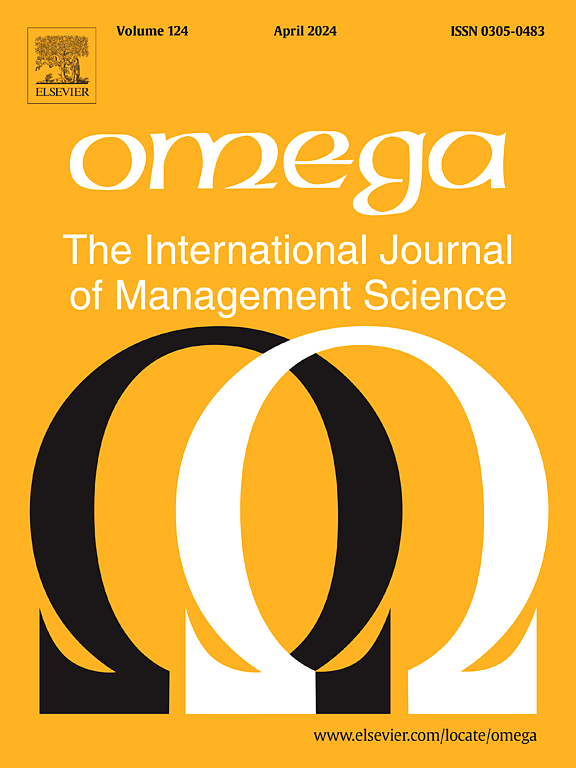考虑性能保证的电动汽车电池租赁策略
IF 7.2
2区 管理学
Q1 MANAGEMENT
Omega-international Journal of Management Science
Pub Date : 2025-08-07
DOI:10.1016/j.omega.2025.103398
引用次数: 0
摘要
电动汽车(ev)因其环保效益而受到广泛欢迎。但是,电动汽车电池属于资本密集型产业,其性能会随着使用次数的增加而下降,因此与汽油动力汽车相比,其市场竞争力有所下降。为了解决这个问题,电动汽车制造商推出了电池租赁服务(BLS),以降低消费者的前期成本,并提供了性能保证保修政策(PGWP)。然而,与PGWP相关的高额前期生产成本和维护费用给制造商带来了财务负担和风险。因此,本研究以实际案例为基础,引入一家电池资产公司(BAC),探讨PGWP下提供电池资产的相关定价策略,并考察与BAC的各种合作模式对制造商的影响。研究结果表明,消费者和企业的总折扣因子之间的关系显著影响电动汽车车身和BLS的定价策略。当消费者的总折扣因子较低时,就会出现“剃须刀片效应”。此外,我们发现BAC的成本优势是制造商合作策略的主要驱动因素。有趣的是,尽管制造商向BAC出售电池同时保留BLS运营责任的合作模式在理论上是最不利的选择,但当电池维护成本相对较高时,它可以产生最高的短期回报和现金流保护。此外,在成本收益比约束下,这种协作模式还可以有效缓解制造商的资金压力,使其实现盈利最大化。本文章由计算机程序翻译,如有差异,请以英文原文为准。
Battery-leasing strategies for electric vehicles considering a performance guarantee
Electric vehicles (EVs) have gained significant popularity due to their eco-friendly benefits. However, EV batteries are capital-intensive and their performance deteriorates with usage, which undermines their market competitiveness compared to gas-powered cars. To address this issue, EV manufacturers have introduced battery-leasing services (BLS) to reduce the upfront cost for consumers and have provided a performance-guaranteed warranty policy (PGWP). Nevertheless, the high upfront production costs and maintenance expenses associated with PGWP impose a financial burden and risk on manufacturers. Therefore, based on real-world cases, this study introduces a battery asset company (BAC) to explore related pricing strategies for providing BLSs under PGWP and to examine the impact of various collaboration models with BAC on manufacturers. The findings reveal that the relationship between the total discount factors of consumers and firms significantly influences the pricing strategies of EV bodies and BLS. When consumers’ total discount factor is relatively low, the “razor-blade effect” emerges. Furthermore, we identify that the cost advantages of BAC are the primary drivers of manufacturers’ collaboration strategies. Interestingly, although the collaboration model where manufacturers sell batteries to BAC while retaining BLS operational responsibilities is theoretically the least favorable option, it can yield the highest short-term returns and cash flow protection when battery maintenance costs are relatively high. Additionally, under cost-revenue ratio constraints, this collaboration model can also effectively alleviate manufacturers’ financial pressure, enabling them to achieve maximum profitability.
求助全文
通过发布文献求助,成功后即可免费获取论文全文。
去求助
来源期刊

Omega-international Journal of Management Science
管理科学-运筹学与管理科学
CiteScore
13.80
自引率
11.60%
发文量
130
审稿时长
56 days
期刊介绍:
Omega reports on developments in management, including the latest research results and applications. Original contributions and review articles describe the state of the art in specific fields or functions of management, while there are shorter critical assessments of particular management techniques. Other features of the journal are the "Memoranda" section for short communications and "Feedback", a correspondence column. Omega is both stimulating reading and an important source for practising managers, specialists in management services, operational research workers and management scientists, management consultants, academics, students and research personnel throughout the world. The material published is of high quality and relevance, written in a manner which makes it accessible to all of this wide-ranging readership. Preference will be given to papers with implications to the practice of management. Submissions of purely theoretical papers are discouraged. The review of material for publication in the journal reflects this aim.
 求助内容:
求助内容: 应助结果提醒方式:
应助结果提醒方式:


